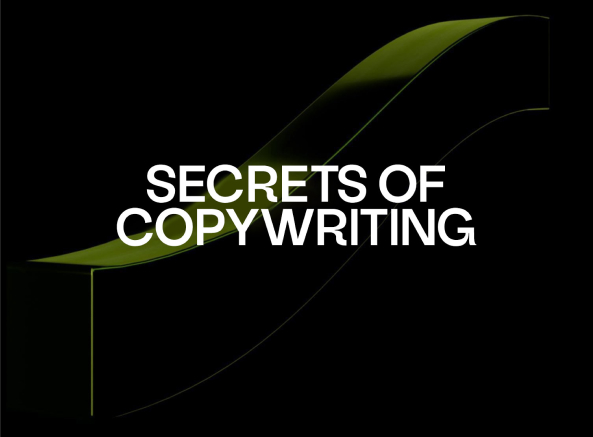
Secrets of Copywriting

Be aware & get inspired.
If you’re thinking about being more active on social media, particularly in a professional capacity, it’s perhaps obvious, but massively important, to ensure you keep your eyes, ears, and mind open when consuming the world around us. When we write copy or produce creative ideas, our thoughts are often shaped and guided by our interests. It’s only human.
Exposure to music, film, stand-up comedy, podcasts, and many other art and non-art forms can be sources of influence, inspiration, or just the smallest spark you need to create something. So, the bottom line here is WAKE UP, and stay awake, as the ol’ brain consumes media indoors, outdoors, and online. Having your phone on hand to snap or screenshot those moments almost make this too easy if you’re always aware.
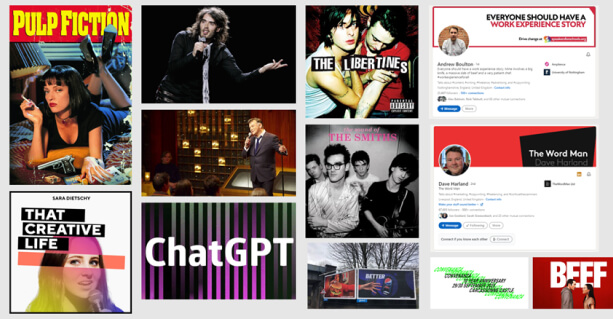
Many people see copywriting as being mostly about selling, but we see storytelling, education, invitation, or engagement as reasons to have powerfully written copy too.
Never post something for the sake of it though! Make sure you have a content strategy in place and then think about how your copy can catch attention. You ALWAYS need a hook. Whether that’s the visual, an amazing line, or post copy that drives intrigue, you always need to stop the reader in their tracks to halt the scroll!
Example: iPod launch campaign
Here’s a slightly retro, but very good example of how copy can sell to different audiences with a small twist on the language used.
Changing the tangent from product features to benefits makes the second line below more emotional and less practical. It sells a dream rather than the product features themselves.

Find a way your product or service can benefit your audience’s lives. Remember, you have an extremely short time to grab attention, so do it quickly.
Know your audience
Before you write copy or create visuals, remember to ask yourself, “who am I talking to and why will they care?” The language you use should not only represent yourself and your company, but it should appeal to the people you are talking to.
A great starting point is to also ask yourself what do you want your audience to THINK / FEEL / DO when they see your comms?
Copywriting fundamentals
Before we launch straight into talking about social media copy, we thought it would be helpful to share some basic copywriting principles that will help you across all your creative comms.
1. Keep it short
- Character limit: many social media platforms have a word or character limit, or before the intro post copy gets truncated so it’s worth bearing this in mind.
- Attention time: on social media, you have around 3-5 secs to grab attention. What’s your hook?
- Shorten your sentences: make them as punchy and interesting as possible.
2. Write how people speak
- This doesn’t mean we should write exactly how people speak, but definitely less formally or robotic. Make it easy on the eye and mind!
- Be more relatable to your followers and use abbreviations ― they’re natural and help words to flow in written form!
- Don’t be afraid to break rules (even grammatical ones).
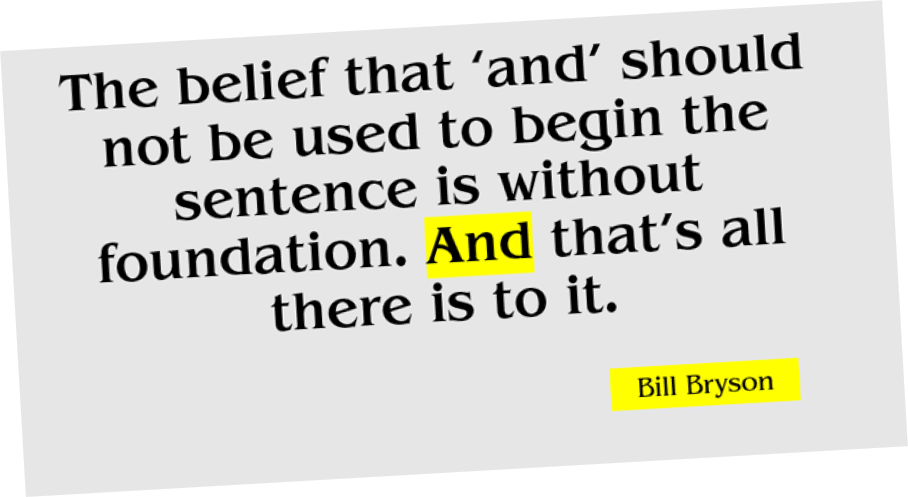
3. Read your copy aloud.
- The best way to check if your copy is ready to be published is to read it aloud. How does it sound?
- Readers won’t speak out loud, but words and sentences will sound off in their minds.
- Stay in the active voice (was landed by the pilot vs. pilot has landed the plane. This is known as the ‘by zombies’ rule and helps to keep things current and in the now.


4. Personalize your copy
- Use personal pronouns: “I”, “we”, “you”, and “us” to drive unity.
- Personalize your company: people only really care about people.
- Shrink the distance between you and your followers.
Copywriting for social media
Ok, so now we’ve covered some copywriting fundamentals, let’s take a look at copywriting for social media. Your social media content should work together like a tightly rehearsed band across the visual, visual copy, and social post copy.
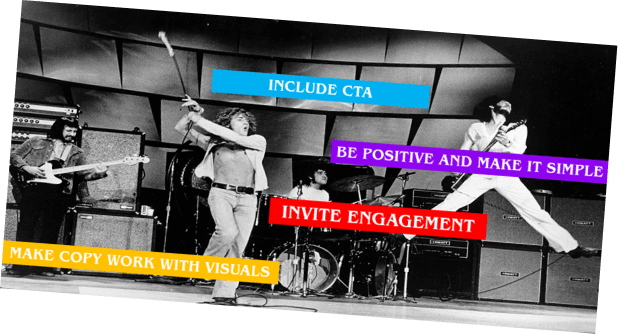

Make your copy work with visuals
- Don’t repeat what’s in the visual, followers aren’t stupid 😊
- Copy must be in line the with visual and complement it.
- How can you use puns, play on words, and other forms to create intrigue?
Invite engagement with a CTA
- Ask the audience’s opinion
- Don’t be insincere
- Be clear and explicit with your audience
- Spark conversation or any action with a CTA

Be positive & keep it simple
This doesn’t mean you always have to be happy but never set a negative tone (words such as despite, or nevertheless can do this as an example.)
- Don’t criticize others
- Make people smile
- Make posts easy to read
- Use bullet points
- Keep paragraphs up to 2-3 sentences (let the eye & mind breathe)
Watching it all come together
As you can see in the example below from Circle K, the copy in the post works in tandem with the visual, incorporating each of the key components we discussed to engage the audience and drive action.
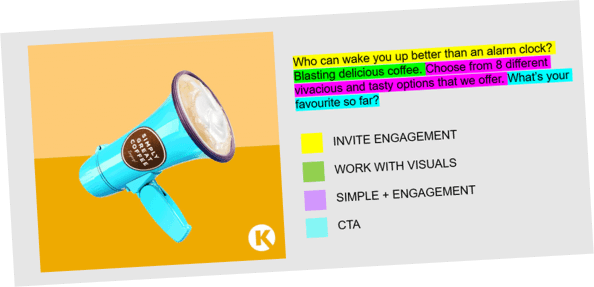
Know who you’re talking to
- Define your follower (the audience).
- You have to visualize who you‘re talking to (engineer, businessman, student, etc.)
- If you’re talking to everybody — you‘re talking to nobody.
- Create an audience profile (and write it down). Think about what will appeal to them with your content. Not only what you say, but how you say it.
What’s your tone of voice (TOV)?
The ‘how’ is often determined by your tone of voice and the way we deliver our messaging, which can be done in a variety of ways. Here are some examples.
- Educational
- Humorous
- Youth targeted
- Informative
- Provocative
- Caring
- Conversational
- Professional
- Expert
Don’t forget, these can be combined also. One way of defining your TOV could be to think about your brand as a celebrity personality. Who would it be and what traits of their personality would you convey? You can also visualize the traits as a sort of mixing desk ― what would you dial up and down to suit your audience from the tone of voice varieties?

Examples of TOV
Here are some examples of brand tone of voice.
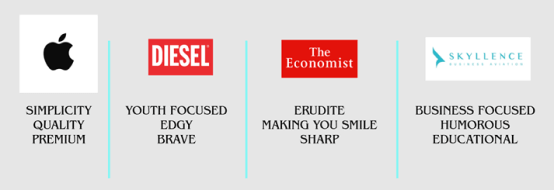
And here’s how these same brands use their tone of voice through external comms…

Shortening copy
There are some simple grammatical ways in which we can shorten copy.
- Character limit: many social media platforms have a word or character limit, or before the intro post copy gets truncated so it’s worth bearing this in mind.
- Attention time: on social media, you have around 3-5 secs to grab attention. What’s your hook?
- Shorten your sentences: make them as punchy and interesting as possible.
- Cut pronouns: We can’t wait to see what you send us > Can’t wait to see what you send us
- Kill adverbs: The winners smiled proudly for their photos > The winners beamed for their photos
- Respect absolute adjectives: Our flight was completely amazing > Our flight was amazing
Summary
Overall, we want our copy to be:
- Shorter. Use lists, bullets, commas, and full stops to break up the text to make it easier and enjoyable to read.
- Sharp & punchy – grab attention.
- Utilizing an engaging CTA so that our readers know what we want them to action.
- Allowing the eye / mind to breathe – good copy is like a rhyme.
- Well-paced. Your sentence length should be choppy vs. boringly long.

Great visuals complete great
copy & concepts
Ensure your copy complements your visuals & vice versa. Here are some nice handpicked examples…

Be aware & be quick
As we mentioned at the beginning, being aware of what’s happening around us is key and can open up many opportunities by piggybacking on what’s current at the time.
Don’t be afraid to borrow inspiration.
Obviously, we don’t advise any blatant copying of ideas, but brands borrow and recycle inspiration all of the time. As long as you have your own spin and point of difference, let others inspire you.

AI Tools
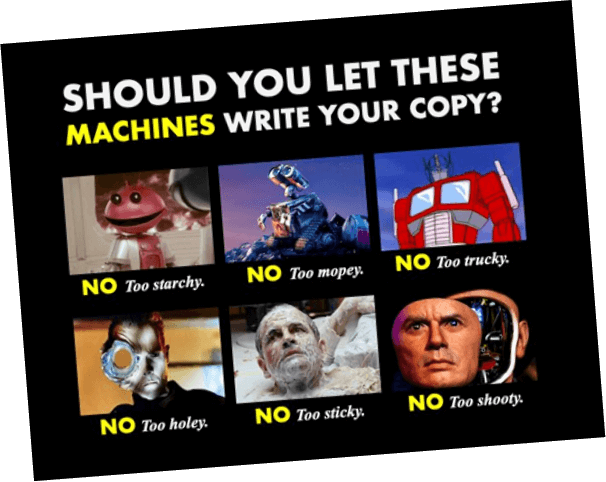
Copywriting tools such as Chat GPT can also be useful to copywriters if used responsibly. Here are our rules for using such tools effectively.
- RULE #1 – DO NOT COPY & PASTE BLINDLY!
- RULE #2 – DO NOT COPY & PASTE BLINDLY! (this is repeated purposely!)
- RULE #3 – Use for “heavy-lifting” & research, not final product
- RULE #4 – Remove obvious AI intros & giveaways
- RULE #5 – Read, check, edit, add & fact check
- RULE #6 – Add your own personality to AI monotone vibes
You can read more about how copywriters and marketing teams can utilize AI tools such as ChatGPT
and Midjourney in our previous blog Rise of the machines: How marketers can utilize AI tools